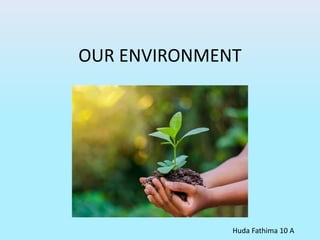
Our environment
- 1. OUR ENVIRONMENT Huda Fathima 10 A
- 2. Ecosystem • An ecosystem is all the different organisms in the world living together in a particular environment or habitat. Our own bodies are homes to tiny living organisms. All the ecosystems combined together make up the biosphere. • An ecosystem is an environment in which plants (flora) and animals (fauna) live. Ecosystems survive through the interactions between plants and animals and an example of this is what are referred to as food chains and food webs. Without these interactions, ecosystems risk breaking down and could be destroyed . •Ecosystem is the collection of organisms in an area along with the important environmental factors. Eg: ocean ecosystem
- 3. Types of ecosystem •Natural ecosystems :- like forests, deserts, grass lands, mountains, ponds, lakes, rivers, oceans etc. •Artificial ecosystems :- like gardens, parks, crop fields, aquarium, zoo etc.
- 5. Components of ecosystem •Abiotic factors Nonliving chemical and physical components of the environment like the soil, air, water, temperature, etc. •Biotic factors Living organisms of the environment like the plants, animals, microbes, and fungi.
- 6. Biotic factors Producers Consumers 1)Herbivores 2)Carnivores 3)Omnivores Reducers/ Decomposers
- 7. Producers Organisms that produce their own food from simple inorganic substances such as water and carbon dioxide are called producers. Examples are green plants and blue-green algae.
- 8. Consumers The organisms which consume the food produced either directly or indirectly are called consumers. Consumers can be classified into primary, secondary and tertiary consumers based on their mode of nutrition. All herbivores and some parasites are primary consumers. Example- rabbit, which eats grass. Many small carnivores and some parasites are secondary consumers. Example- snake, which eats rabbits. Larger carnivores and omnivores are tertiary consumers. Example- owl, which eats snakes.
- 9. Decomposers Organisms that use the organic matter of dead plants and animals are called decomposers. They release digestive enzymes to break down organic matter and then absorb the products of digestion. Decomposers include fungi and bacteria. Decomposers do not fit readily into one trophic level.
- 10. Food Chain A food chain is a linear sequence of links in a food web starting from a species that are called producers in the web and ends at a species that is called decomposers species in the web. A food chain also shows how the organisms are related with each other by the food they eat. A food chain differs from a food web, because the complex polyphagous network of feeding relations are aggregated into trophic species and the chain only follows linear monophagous pathways. A common metric used to quantify food web trophic structure is food chain length. In its simplest form, the length of a chain is the number of links between a trophic consumer and the base of the web and the mean chain length of an entire web is the arithmetic average of the lengths of all chains in a food web
- 11. Difference Between Food Chain And Food Web Food Chain • A food chain only follows just one path as animals find food. Food Web • A food web consists of many food chains.
- 12. Trophic levels Each step in a food chain where transfer of food energy takes place is called trophic level. The first trophic level consists of producers. The second trophic level consists of primary consumers. The third trophic level consists of secondary consumers. The fourth trophic level consists of tertiary consumers. Since the transfer of food energy decreases at every trophic level, the number of trophic levels are limited and do not exceed four or five.
- 14. Energy flow in trophic levels Green plants (producers) absorb about 1% of solar energy falling on the leaves and stores it as food energy during photosynthesis. During the transfer of food energy from one trophic level to the next, 90% of the energy is lost to the environment and only 10% is transferred to the next trophic level. So there is a decrease in the amount of food energy transferred at every trophic level by 10%. This is known as the 10% law.
- 16. Depletion of ozone layer in the atmosphere Ozone molecule contains three oxygen atoms (O3). At higher levels in the atmosphere the UV radiation splits some oxygen molecules (O2) into free oxygen atoms which combines with oxygen molecules (O2) to form ozone. It is highly poisonous. UV radiation O2 O + O O2 + O O3 The ozone layer present in the higher layer of the atmosphere protects the earth from the harmful UV radiation from the sun. UV radiation causes skin cancer in humans. The ozone layer is being damaged by the use of chemicals like chloro fluoro carbons (CFCs) used in refrigerators and fire extinguishers. So the use of CFCs is now being reduced to protect the ozone layer.
- 18. Managing the garbage we produce The household waste is called garbage. Some of the garbage is biodegradable and some are non biodegradable. Garbage causes pollution of air, water and soil. So it should be disposed properly. Some of the methods of garbage disposal are :- i) Land fills ii) Recycling iii) Production of biogas and manure iv) Preparation of compost v) Incineration vi) Sewage treatment
- 19. Land fills Recycling Production of biogas and manure Preparation of compost Incinerator
- 20. Sewage treatment